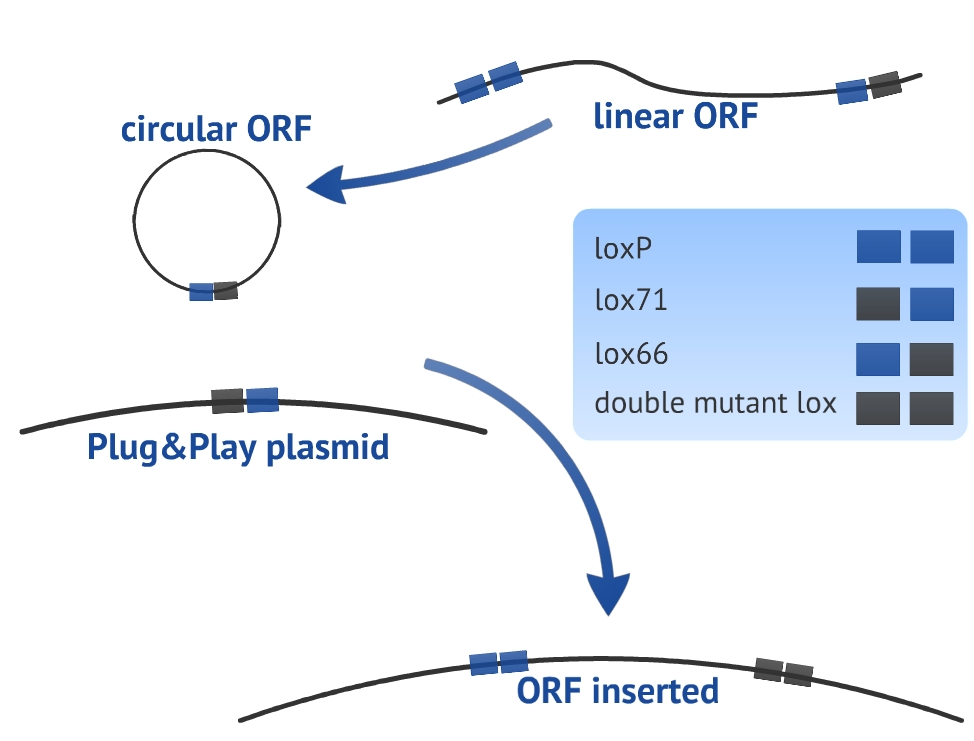Team:USP-UNESP-Brazil/Plasmid Plug n Play/Introduction
From 2012.igem.org
Andresochoa (Talk | contribs) |
|||
| (13 intermediate revisions not shown) | |||
| Line 1: | Line 1: | ||
| - | + | {{:Team:USP-UNESP-Brazil/Templates/Header}} | |
| - | + | <h1 id="The Plug&Play Machine">The Plug&Play Machine</h1> | |
| - | The Plug & Play system | + | The goal of this project is to build a prototype machine to produce/screen biological parts in high-throughput manner. This is the first step for characterizing/producing new biological standard parts, which is a huge necessity in the synthetic biology field. To help in this task we developed a prototype plasmid for a machine called Plug&Play, it express any protein helped by the Cre-Recombinase system. This machine will be a tool for an easy and rapid protein expression, which aims to decrease the time used in screening candidate genes that encode proteins of biological interest. It only uses parts from the Registry of Standard Biological Parts, allowing its free use by the synthetic biology community. |
| - | + | As a proof of concept, we proposed to build a single plasmid that allows the expression of any protein in ''E. coli'' using two steps: PCR (Polymerase Chain Reaction) and bacteria transformation. The system is based on the Cre recombinase protein that catalyzes DNA recombination between specific recognition sites. | |
| - | + | The Plug&Play system consist of two parts; | |
| + | i) primers to amplify the desired ORF (open reading frame) - the primers sequences must be flanked by the recombination sequences loxP and lox66, which will be recognized by the Cre recombinase. | ||
| + | ii) a receptor plasmid - the Cre recombination mechanism will strategically insert the PCR-amplified DNA at the lox71 site, and readily express the protein once the receptor plasmid already posses all the necessary protein expression machinery. | ||
| - | |||
| + | {{:Team:USP-UNESP-Brazil/Templates/RImage | image=Pplay_fig.jpeg | caption=ORF circularization and insertion in the Plug&Play plasmid | size=600px}} | ||
| - | |||
| - | The Cre expression levels are critical for the system performance, | + | |
| + | We intended to test three different plasmids: a low copy number plasmid (pSB4A5), a high copy number plasmid (pSB1C3) and a commercial high copy number plasmid (pET15b). The comparison of these three plasmids will identify the best system for the developing of this technology. | ||
| + | |||
| + | Since the Cre expression levels are critical for the system performance, we created two different versions for each of the three plasmids, A (lox71-Cre) and B (Cre-lox71). We want to test if inserting the target gene either upstream or downstream the Cre gene will affect the expression efficiency. | ||
| + | |||
| + | {{:Team:USP-UNESP-Brazil/Templates/Foot}} | ||
Latest revision as of 22:29, 25 September 2012
 Introduction
Introduction Project Overview
Project Overview Plasmid Plug&Play
Plasmid Plug&Play Associative Memory
Associative MemoryNetwork
 Extras
ExtrasThe Plug&Play Machine
The goal of this project is to build a prototype machine to produce/screen biological parts in high-throughput manner. This is the first step for characterizing/producing new biological standard parts, which is a huge necessity in the synthetic biology field. To help in this task we developed a prototype plasmid for a machine called Plug&Play, it express any protein helped by the Cre-Recombinase system. This machine will be a tool for an easy and rapid protein expression, which aims to decrease the time used in screening candidate genes that encode proteins of biological interest. It only uses parts from the Registry of Standard Biological Parts, allowing its free use by the synthetic biology community.
As a proof of concept, we proposed to build a single plasmid that allows the expression of any protein in E. coli using two steps: PCR (Polymerase Chain Reaction) and bacteria transformation. The system is based on the Cre recombinase protein that catalyzes DNA recombination between specific recognition sites.
The Plug&Play system consist of two parts;
i) primers to amplify the desired ORF (open reading frame) - the primers sequences must be flanked by the recombination sequences loxP and lox66, which will be recognized by the Cre recombinase.
ii) a receptor plasmid - the Cre recombination mechanism will strategically insert the PCR-amplified DNA at the lox71 site, and readily express the protein once the receptor plasmid already posses all the necessary protein expression machinery.
We intended to test three different plasmids: a low copy number plasmid (pSB4A5), a high copy number plasmid (pSB1C3) and a commercial high copy number plasmid (pET15b). The comparison of these three plasmids will identify the best system for the developing of this technology.
Since the Cre expression levels are critical for the system performance, we created two different versions for each of the three plasmids, A (lox71-Cre) and B (Cre-lox71). We want to test if inserting the target gene either upstream or downstream the Cre gene will affect the expression efficiency.
 "
"
















